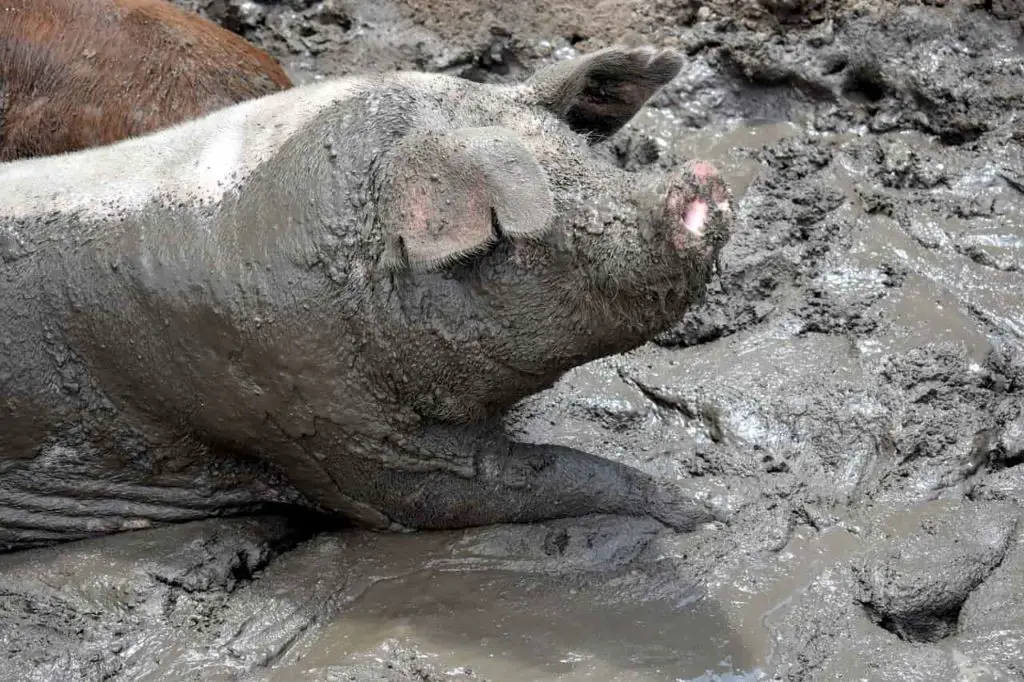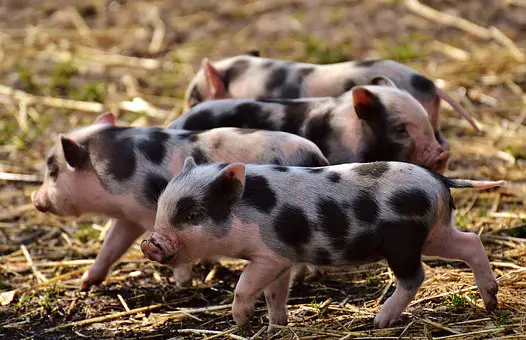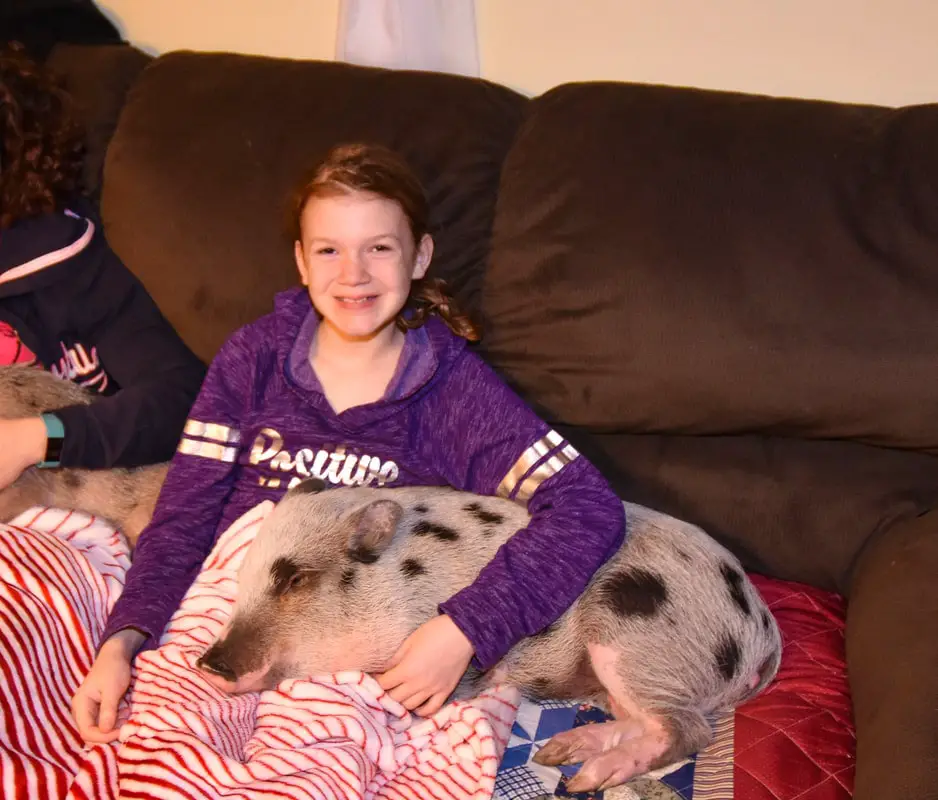Do you own a pig? Are you a new pet pig owner? Pigs are becoming popular and we are definitely curious about them! Here are some facts about pigs.
Get to know pigs
- Pigs are very clean animals
- Pigs are intelligent animals
- Pigs can be house trained like dogs
- All pigs can grow tusks
- Pigs are social animals
- Pigs are not picky eaters
- Pigs can be emotional
- Pigs wag their tails when they are happy
- They only like to roll around in mud to cool off
- Most pigs love cooked broccoli
- Pigs can eat grass, roots and certain insects
- Pigs are usually quiet
- A pig can be sweet and cuddly
- The average lifespan of a domesticated pig is 15 to 20 years. Wild pigs only live 4 to 8 years.
- A young female pig that has never been pregnant is called a “gilt” and pigs that are already mothers are called “sow“
- All male pigs are called “boars”
- Pigs are gentle and can be very friendly
- Pigs are prey animals
- Pigs can start breeding as soon as they reach six months of age.
- Pigs can’t fly, but they can definitely learn how to swim
- Pigs have great memory
- Pigs are omnivores
- They have poor eyesight
- But they have a great sense of smell
- A pig’s snout (the nose) is sensitive to touch.
Knowing these facts, your curiosity will probably start wanting more. We’ll discuss these facts in greater detail, one by one!
1. Pigs are clean animals
Despite being known as a “filthy” animal, pigs are actually surprisingly very tidy. As much as possible, they would like to keep their toilet separated or away from their living and feeding area.
Related to fact number 9, pigs have trouble cooling off due to their dysfunctional sweat glands.
Yes, they do have sweat glands.
It simply does not work the way it should be and that is why they usually can’t adjust to extreme temperature or weather conditions compared to other animals.
If given access to water, a pig would prefer to cool off with it.

But most of the time, the only access they have is mud. Aside from helping them cool off, having mud around their body also fends off pests or parasites like flies.
Your pig may not like baths at first as they might not be used to it, but as long as you bathe them regularly without making them feel threatened, they will eventually learn how to enjoy it.
2. Pigs are intelligent animals
Pigs are surprisingly considered the fifth most intelligent animal in the world and may even be more intelligent than dogs and several other primates.
They are so intelligent and can learn their names as fast as they reach two to three weeks old. Despite their young age, they will know how to respond when called.
After several intelligence tests, studies determined that they can respond and play video games better than chimps or monkeys that are popularly known for being smart.
Pigs are capable of having better focus and producing a higher success rate in IQ tests compared to monkeys.
3. Pigs can be house trained like dogs
Given with fact number two, pigs are smart.
This intelligence allows them to be trained easily. Some people who owned both pigs and dogs even claim that they are easier to deal with, easier to train and care for than dogs.
Training them is very similar to how most people train their house pets. Pigs can learn how to use the litter box, learn several tricks, remember rules and respond to commands.
They can also learn how to play fetch which will be a great activity for a pig. Any pig will need enough walking and running around to stay fit and healthy.
Caretakers and owners both claim that rewarding them with treats proved to be one of the most effective conditioning or training method.
It’s advised to try the treat-reward method first before testing other things.
The fact that pigs can be house trained is one of the main reasons why they are becoming popular as pets. They help their owners make coexisting with each other a lot easier by learning house rules.
4. All pigs can grow tusks
All pigs can grow tusks even if they are wild, domesticated, male or female. All breeds will have tusks too!
Tusks can help people identify genders. Female pigs tend to have shorter or smaller tusks that usually don’t grow large enough to stick out of their mouths to the point that people thought female pigs don’t have tusks.
Male pigs will require adequate tusk maintaining care as their tusks can grow large and if kept as a domestic animal, could pose a threat to other nearby animals including people.
There are rare cases when tusks may grow abnormally large, grow into the wrong direction and cause damage to the gums and jowl area.
If you own a pig and want to know more about how hooves and tusks care, you can visit our detailed article about it here. Scroll to the bottom for the tusks section.
There is separate article solely dedicated to tusks information. You can follow this link:
5. Pigs are social animals

Often times, pigs enjoy having a companion rather than staying on their own. Domesticated pigs can be lonely without social interaction and may grow depressed.
Getting one as a pet doesn’t automatically mean you will need to give them a partner or a permanent companion.
So long as you are providing them with enough care and attention, your pig can still be happy and enjoy its life as a pet.
Wild pigs can be seen traveling in pairs or more. It is usually a mother pig (sow) and her piglets (litter). They are prey animals and traveling together reduces the risks of being attacked by predators.
Females tend to band together while male pigs are capable of being distant and alone.
A group of young pigs is called a “drift“, “drove” or “litter“.
A group of older pigs is called a “sound” or “sounder of swine” as well as “a team or passel of hogs” and lastly, a “singular of boars“.
6. Pigs are not picky eaters
Pigs can eat almost anything! This is another factor that makes them awesome pets. Owners don’t have a hard time figuring out the best treats to give their pet.
However, pigs need a balanced diet to stay healthy and fit as obesity is one of the most common problems among pet pigs.
To provide this, they will need various type of food. Pigs can eat different kinds of fruits and vegetables!
It is said that a real pig pellet can be the healthiest choice of feed for your pig as it provides all the nutrients a pig would need.
7. Pigs can be emotional
Since they are really smart, pigs are capable of feeling both negative and positive emotions.
They wag their tail when they are happy, grunt when they feel threatened and cry real tears when grieving.
Studies say that pigs are aware when a good companion passes away or when owners abandon them. Giving them away to other people can cause depression.
They know how to mourn and they can sense grief from other animals including people. When they do, they may console the grieving animal or person for comfort.
This is why pigs are capable of being an emotional support animal or a therapy animal that can help reduce depression in people.
Pigs with good mothering skills can also assist in nursing certain orphaned animals because of their compassion for others.
8. Pigs wag their tails when they are happy
Like what is stated in fact number 7, they do wag their tails out of joy. Most domestic breeds now have curly tails while most wild breeds have straight tails.
The truth behind the origin of curly tails still remains a mystery and only has theories that may be logical, but have no scientific confirmation yet.
Anyway, the important thing is people can tell if a pig is pleased or excited when they can see them wagging their tails!
The only known purpose of a pig’s tail is warding off pests or flies.
Curious about the theories on why pigs have curly tails? You can check our article about it here.
9. They only like to roll around in mud to cool off
Referring to fact number one, the only way most pigs can cool off is through rolling in mud.
This is once again, because of their inability to sweat.
Since this activity became common for them, it has become part of their natural instinct and developed a natural liking for mud.
This natural behavior means that even if you do regularly give them proper baths, sometimes, they might still enjoy playing in the mud because that’s what their race have always known to do.
There is no harm in letting your pig play in the mud once in a while as it is their nature and domestication is the only thing that takes away their natural behavior.
10. Most pigs love cooked broccoli
Many pig owners firmly state that their pigs loved cooked broccoli! Since they are not picky eaters, you can expect your pig to love the same thing other pigs enjoy.
Even so, just like people, different pigs may have different preferences as they have individual personalities.
If cooked broccoli doesn’t work for your pig, there are still a lot of food choices to choose from to satisfy your pig.
11. Pigs can eat grass, roots and certain insects
If you own a pig and would like to save a bit of your budget when feeding them, you can take them outside and let them graze on grass.
They will dig up the ground too to search for edible roots and several insects.
Pigs will instinctively know what’s dangerous for them to consume, so it’s okay to let them do this once in a while.
Before doing this, it’s important to know that you must still be nearby and supervise your pig so they don’t eat junk, scrap food or other leftovers that they might stumble on.
Grass, roots and insects may not be enough for your pig’s appetite, it may only be the same portion of a pig’s treat.
12. Pigs are usually quiet
This is another reason why pigs are loved as pets. They don’t make too much noise such as barking or excessive meowing. Of course, each pet or animal have their pros and cons.
Pigs are naturally quiet because they are prey animals. They avoid making unnecessary noise in order to reduce the risks of being tracked by a predator.
Even as domesticated animals, pigs still carried this trait and it’s completely understandable.
Despite the quiet personality, they are still capable of making sounds as a form of communication.
The sound they make is famously called an “oink” because it sounds like it! Other terms are grunting, snorting and squealing.
Pigs can actually be very vocal when they are in their comfort zone and it’s their easiest way of communicating with other pigs. If you own a pig, you can observe the tone of their “oinks”.
Matured pigs that are ready to reproduce can do a certain “song” or “mating call“. The sounds they make can have different meanings and learning them naturally can be very fun for owners.
13. A pig can be sweet and cuddly
Because of the stigma revolving pigs, people didn’t think they can be sweet and capable of appreciating physical contact.
Once you have earned their trust, feel comfortable around you and absolutely adore you, they can come to you on their own.
They will enjoy sitting on your lap or even cuddle with you.

Most of the time, pigs are easily frightened and dislike being held down, picked up or held for too long.
However, once you get past their comfort zone, they will definitely surprise you with how clingy they can be.
14. The average lifespan of a domesticated pig is 15 to 20 years. While wild pigs only live 4 years up to 8 years.
As long as they are well cared for, domestic breeds tend to live a lot longer than their wild counterpart. Normally, the expected lifespan is only 10 to 15 years because of unnatural cause of death.
But recently, more and more people are giving proper love and care for pigs. This is why their lives are no longer cut short by people.
Wild pigs live shorter because of their environment. They often die from being hunted or consumed by predators.
Harsh or extreme weather conditions can also be fatal for pigs that don’t have proper shelter like domestic pigs.
15. A young female pig that has never been pregnant is called “gilt” and pigs that are already mothers are called “sows”
When you own a pig, it’s also nice to know a little side information on what terms to use when properly referring to them. Usually, owners will get gilts instead of sows.
16. All male pigs are called “boars”
Regardless of breed, all pigs are termed the same. Young pigs can be referred to as “litter”
Farm owners often have more gilts than boars for easier population control and breeding management.
17. Pigs are gentle and can be very friendly
In general, domesticated pigs are not dangerous or aggressive.
They are docile and friendly towards other animals and people to the point that you can let them be near children.
Many owners state that pigs have a behavior similar to dogs.
They usually won’t attack unless provoked, cornered or feel deeply threatened. However, this rarely happens as pigs will rather prioritize escaping more than defending.
Their good nature allows them to get along with other house pets such as cats and at times, even dogs. This is also why people like to have pigs as pets because they can easily coexist with other animals.
18. Pigs are prey animals
Pigs are the main targets of medium to large sized predators like lions, cheetahs, leopards, tigers and other strong animals. Sometimes, even snakes!
Being a prey embedded a natural instinct for pigs to prioritize fleeing when in danger.
However, male pigs or boars can find themselves cornered and may resort to fighting back using their tusks and biting their attacker.
Another possible reason why pigs roll around in mud aside from cooling off and fending off parasites, it could also be a way to MASK THEIR SCENTS.
In the wild, animals are very cautious and pay close attention to every detail. They familiarize with scents most of the time to get by and easily track down their next meal.
Although pigs do not sweat or should naturally be odorless, their environment will let them develop a distinct smell which predators will remember.
One way for them to mask their scent is by covering it up with another natural scent such as dirt or mud. It may not be perfect, but can be helpful.
It can confuse predators and this is another proof of how smart they can be, by outsmarting predators in the wild.
19. Pigs can start breeding as soon as they reach six (6) months of age.
If you’re planning to own a pig as a pet, it’s highly recommended to get them spayed and neutered.
Want to learn more about breeding pigs? We have a helpful article about it that will answer your questions. Read the article here.
20. Pigs can’t fly, but they definitely can learn how to swim!

In the capital of Bahamas, there are beaches that have become a tourist attraction because of the swimming pigs! Nassau, the capital city of Bahamas is growing popular because of their swimming pigs.
Pigs would prefer water than mud but at first, they might not like baths. However, as long as you get them used to it, they will eventually enjoy it.
When your pig learns how to swim, you can turn this into a fun exercise or activity for both you and your pig! Together, you can stay fit.
21. Pigs have a great memory
Studies say that they can remember specific things even a year later or more!
They will remember the faces of their owners or the people who mistreated them. They can recognize and tell the difference between objects, voices of people and several other things.
Their great memory is another reason why they ranked 5th in the most intelligent animals in the world.
22. Pigs are omnivores
Just like us, they can eat plants and other animals too.
However, for safety precautions and health issues, domestic pigs are strictly prohibited from consuming meat.
It should only be allowed when they are being handled by professionals.
The reason behind this restriction is because of virus outbreaks that happened in the past.
Viruses such as “H1N1 Virus” (Swine Influenza Virus) and “Foot-and-Mouth Disease” (Also known as Hoof-and-Mouth Disease for animals) started with pigs and transmitted the disease to humans.
The easiest way for a pig to get sick or infected by a disease is to consume meat and that is why feeding them with meat must be avoided as much as possible!
23. They have poor eyesight
Pigs are studied to have a dichromatic vision which means they only have two pigment cones that create colors.
When an animal have a dichromatic vision, the way they will see the world is less vibrant or colorful compared to others.
Tests were initiated and most pigs could recognize colors such as black, blue, red, grey, white and brown. They don’t seem to react to or recognize other bright colors like yellow and green.
24. Pigs have a great sense of smell
Despite their poor eyesight, pigs have a great sense of smell which makes up for their bad eyesight. They also have sensitive hearing.
In the wild, they would mostly rely on their smell to search for food and also be alerted by predators or unfamiliar scent that may put them at risk.
Studies stated that pigs can smell odors from 7 miles away and detect odors as deep as 25 feet underground!
With this advantage, they can easily dig the ground using their hooves and dewclaws when they detect insects that they can eat.
25. A pig’s snout (the nose) is sensitive to touch
Great things often come with great consequences.
If you own a pig, one thing you should avoid is playing with their nose!
Pigs might become uncomfortable or even perceive your action as a hostile action when you play with their snouts or even when you accidentally touch it.
Think pigs are awesome? These facts should convince you that they are nothing like their bad image that has been drilled into us by the media or the world for several years!
RELATED QUESTIONS
- Is it legal to own or raise a pig?
The answer depends on where you live. Laws differ on every country especially regarding animal welfare. It’s highly recommended to check with your local officers to verify first before you adopt a pig.
If it requires a license, please register your pig for its safety and yours too. It might also come with various benefits, so it’s worth the cost.
We have a helpful, detailed article on how to get your pig licensed.
- How much does it cost to raise a pig?
An estimated total could take up to $600 and more. It’s natural to wonder about the total costs after finding out about their needs, so here’s a helpful page that can explain all the costs in full detail for you.
Link: https://lovelivegrow.com/cost-to-raise-a-pig/
To explain further with more detail, the feed alone could get expensive. You must also consider the amount of water supply for drinking.
Housing or bedding if they are indoor pets is necessary for comfort too. Medications and treatments should be added to your calculations and lastly, if it’s required, licensing may cost some money as well.
Please be reminded that prices may differ depending on your country or area therefore we can only provide an estimated amount.

